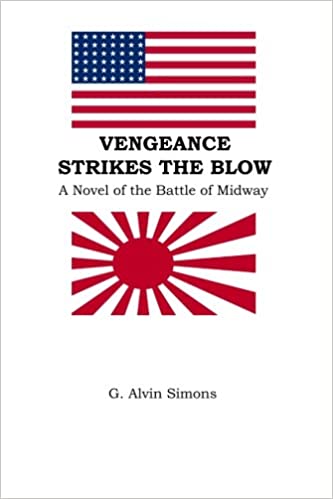Reviewed by Tyler Robinson
Vengeance Strikes the Blow is a remarkably vivid and grounded read, particularly given that it is such a departure from G. Alvin Simons’ prior historical-fiction novel, Odin-Son: The Berserk Saga. Much of the text reads as Socratic dialogue on the subject of tactics, not unlike Niccolo Macchiavelli’s The Art of War. The tone is also reminiscent of Euan Montague’s The Man Who Never Was, a gripping account of the World War Two Royal Navy’s “Operation Mincemeat” stratagem, but while Montague was able to provide a narrative nonfiction account of the operation that was his brainchild, the scope of the Battle of Midway demanded a novelization to fill in the blanks between personal narratives.
The book’s 68 chapters are divided between nine American and two Japanese point of view characters, a large cast quite sensibly introduced in the frontmatter. This cast of characters may be tricky for casual readers to keep track of at times, but it helps avoid the overly simplistic hero worship of a single individual that bedevils certain historical accounts, as it shows the collaborative nature of operational decisions even when guided by a clear chain of command. It also serves to provide an overview of the various air and sea crafts at play in the battle.The first and final chapters are told from the perspective of Rear Admiral Ryunosuke Kusaka (Chapters 1, 4, 21, 25, 29, 35, 45, 47, 52, 58, 63, 78, 84, 86), and showcase how dramatically Japanese opinion of their American adversaries have shifted before and after the events of June 4, which comprise the bulk of the book (Chapters 34 through 85). Whereas Kusaka provides the point of view for strategic deliberations aboard Admiral Nagumo’s flagship, Lieutenant Joichi Tomonaga’s point of view (Chapters 7, 13, 36, 42, 65, 68, 72, 74) provides a view of those Japanese pilots acting as the point of the spear.
The American characters are introduced more gradually. First is Rear Admiral Raymond A. Spruance (Chapters 2, 12, 26, 38, 49, 66, 70, 82), followed by Rear Admiral Frank J. Fletcher (Chapters 3, 5, 9, 19, 28, 39, 67, 69, 81), operating at the level of strategic decision-making for the American forces at Midway.
Lieutenant Commander John C. Waldron (Chapters 6, 23, 41, 56) provides a view into the cockpit of the Douglas Devastator airplanes of Torpedo Squadron 8, a bomber active at Midway even while being phased out of usage.
Lieutenant Commander John S. Thach (Chapters 8, 10, 17, 31, 54, 61, 64, 73, 75) leads the Wildcats of Fighter Squadron 3 while innovating aerial maneuvers that will help America win the war.
Lieutenant Commander William H. Brockman Jr. (Chapters 11, 33, 40, 50, 53, 57, 59, 71, 77, 83, 85) provides rare insight into the submarine USS Nautilus, which proves a thorn in the side of the Japanese navy.
Corporal Frank L. Melo Jr. (Chapters 14, 32, 44, 46, 55) provides the perspective of a young enlisted man being thrust into the heat of battle for the first time within the confines of a B-26 Marauder bomber.
Major Lofton R. Henderson (Chapters 15, 18, 37, 51) and Commander Logan C. Ramsey (Chapters 16, 22, 24, 27, 30, 34, 43, 79) provide insight into the preparations and operations being based out of Midway itself.
Finally, Lieutenant Richard H. Best (Chapters 20, 48, 60, 62, 76, 80) provides a view inside the cockpit of a Dauntless bomber at the battle of Midway, where he served as a squadron leader.
This novel seeks to distinguish itself from past narratives of the Battle of Midway in part by placing a greater emphasis on the contributions made by Admiral Fletcher’s command of the Yorktown aircraft carrier and Commander Brockman’s Nautilus submarine. The narrative also takes pains to present a sense of symmetry between the struggles faced by the Japanese and American officers. This is perhaps most poignant when both sides are forced to find a replacement for key officers at short notice due to illness. Admiral Halsey is stricken with a terrible rash, forcing Spruance to take his place, while the Japanese strike leader, Commander Mitsuo Fuchida, is taken out of commission by appendicitis, forcing Tomonaga to step in as his replacement. Indeed, much of the challenge faced by both sides has to do with managing accidents and mistakes occurring within one’s own ranks, independent of any interference from their adversaries.
It is easy to become overwhelmed by the sheer amount of scholarship on the Battle of Midway when seeking to learn more about this pivotal moment in World War Two history, but as a novel Vengeance Strikes the Blow presents a less daunting introduction to the conflict. On the other hand, the list of “Further Reading” may be a bit underwhelming for those used to more scholarly reading, as it comprises 15 books and four websites. Similarly, more specific detail regarding Simons’ process in researching the book may have been warranted. Though the narrative is rich in detail and Simons stresses that he used actual quotations and historical details liberally, in the absence of a more comprehensive breakdown of what informed his writing, it is hard to get a sense for where the line between fiction and fact lies, or what he might have missed in his apparently quite extensive research.
Tyler Robinson graduated with an MLitt in International Security Studies from the University of St Andrews in 2018. He has also contributed reports on emerging technologies and geopolitical threats for OODA LLC.
Vengeance Strikes the Blow: A Novel of the Battle of Midway (G. Alvin Simons, Cripple Creek Press, Perry, FL, 2011)


